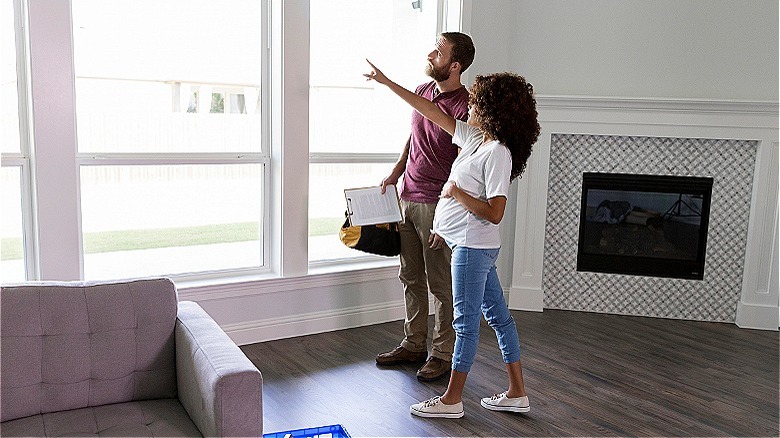Government Programs That Can Help Take The Financial Stress Out Of Home Repairs
Buying and maintaining a home with a comparatively low income is quite an accomplishment and homeowners should be proud they pulled it off. But sometimes that accomplishment goes hand-in-hand with all the challenges of buying a property that needs some work and which, over time, will only need more. To help these homeowners with such inevitable home repairs, and to improve the supply of safe and desirable homes within an area, the United States government, local governments, and not-for-profit organizations have a number of assistance programs that aim to deliver help right where it's needed.
These assistance programs are usually government-insured loans, issued by independent financial institutions. And they're specifically for homeowners, not prospective homebuyers. Also note that in some cases, the assistance might be in the form of grants rather than loans. The programs generally have income limits, property value limits, and restrictions on how funding and loans can be used. Let's take a look at the most prominent loan offerings and a couple of grant programs homeowners might find useful when it comes to lessening the financial stress of needed home reapirs.
Assistance for homeowners with limited home equity
While some loan programs are targeted to those with very low incomes, the Department of Housing and Urban Development's (HUD) Title 1 property improvement loan program is focused on helping those with low and moderate incomes. The assistance program applies to single-family houses, manufactured (mobile) homes, multifamily residences, and nonresidential properties. For homeowners, specifically, it insures home repair and improvement loans. Title 1 loans can be made for up to $25,000 and have a maximum term of 20 years and 32 days. (Manufactured homes and multifamily or nonresidential properties have different limits.) The loans have a fixed interest rate based on market rates in the area. Further, to qualify, the home has to have been lived in for at least 90 days
Title 1 loans are for home repairs and improvements that make a home more "livable and useful," but the program specifically excludes improvements that could be considered luxuries. This program is useful for owners with limited equity in the home, which can make other lending scenarios difficult. But it's not unusual for new homeowners to discover that their houses need some work that went unnoticed until they moved in. Homeowners can apply at any FHA-approved lender. For a list of approved lenders, call (800) 767-7468. Title 1 loans can be used in conjunction with 203(k) home rehabilitation loans.
Assistance for fixer-upper rehabilitation
HUD's 203(k) rehabilitation mortgage insurance program is designed to support home repairs and modernization through refinancing and, in some cases, combining the original home loan and rehab financing into a single 15- or 30-year mortgage with a lower interest rate than other home-improvement loans. For an owner to participate, the home rehabilitation must be $5,000 or more and the property's value must be within the FHA mortgage limits for the area. (You can look up these limits on the HUD website.) The standard 203(k) loan is for more than $35,000, but a special version of this program called a limited or streamline 203(k) allows financing under $35,000.
These home improvements include a wide range of possibilities, from the purely aesthetic to the critically important. A 203(k) loan, often used when buying a fixer-upper, can be used for improving a home's appearance, landscaping changes, building accessibility-oriented features for the disabled, repairing or replacing plumbing, or upgrading an aging roof. The loan can also be used for improving a home's energy efficiency.
Energy efficiency is one home repair, in particular, that can cause low-income homeowners financial stress. While upgrades like better insulation might reduce energy usage and power bills, insulation is far too expensive for the everyday budget. As a result, homeowners have no choice but to pay the monthly price for poor energy efficiency, which is also bad for the environment, comfort, and the home's value ... one of many traps the 203(k) assistance program seeks to eliminate. Like Title 1 applications, 203(k) applications should be submitted through an FHA-approved lender.
Assistance for affordable repair financing in rural areas
The Section 504 Single Family Housing Home Repair loan program, administered by the U.S. Department of Agriculture's Office of Rural Development, backs loans with the goal of making financing more affordable. While Title 1 and 203(k) loans have interest rates closer to the going market rate, Section 504 loans have a 1% interest rate and a 20-year term of monthly payments. The loans allow very low-income homeowners to borrow up to $40,000 for home repairs and improvements to their primary residence.
The owner's income must be below the "very low income" limit, which varies from county to county. Because the loans are intended for rural development, the home must be in an eligible area. To ensure that payments can be made, credit checks are necessary and the borrower's debt is kept below a 41% ratio ... that is, the debt can't be more than 41% of the value of the homeowner's income and assets.
Homeowners who can't find affordable credit may use Section 504 loans to make repairs to improve the health and safety of their homes or make them more usable. The property should be "typical and modest for the area," but the Section 504 documentation doesn't elaborate on this requirement, which might be slightly confusing. Unlike HUD-backed loans, those seeking Section 504 loans should apply through their local Rural Development offices, where you can also request help with the process if you need it.
Assistance for seniors living in rural areas
Section 504 home repair grants have most of the same requirements and features of Section 504 loans, including the same limitations on eligible areas and properties and the same income limits for applicants. But the grants don't have to be repaid unless the home is sold within three years. These grants are only available when one qualified applicant living in the home is 62 or older. Section 504 grants are made for a maximum of $10,000, and the lifetime limit for the program is also $10,000. No credit history evaluation is necessary for grant recipients.
The grants can be combined with Section 504 loans for a total of up to $50,000 in assistance to deal with health and safety hazards in the home. This helps to cover larger home repair and rehabilitation needs while reducing the financial burden on very low-income seniors. Sometimes unexpected home repairs are critical for the homeowner's health and safety, but simply aren't affordable on an older person's (fixed) budget. A septic tank, for example, can't be expected to last much beyond 50 years, and it can cost $5,000 (on average) to replace a basic septic tank ... and much more if there are other problems. As with Section 504 loans, grant applicants should apply through their local Rural Development office.
Assistance from local government funding programs
Sometimes local governments and not-for-profit organizations offer assistance that can't be accessed through federal programs like HUD and the USDA. These programs might be partly funded by the U.S. government, but they're locally administered and are designed to meet the specific needs of a community. These include programs funded by HUD's HOME Investment Partnership Program.
While local HOME programs are often mostly funded by the national government, HUD requires 25% fund matching from participating jurisdictions, which can include local governments and/or non-government organizations. While local needs drive individual HOME programs, some national standards apply that will affect applicants. For instance, a property's value can't exceed 95% of the area's median price, even after rehabilitation is complete. There are also firm income limits, to make sure help goes to those who need it most. This restricts use to extremely low-income (ELI) families. The ELI limit means that a household's income can't exceed 30% of the area's median family income, adjusted for family size.
The funds are made available to cover a broad range of activities, including home rehabilitation, and the specifics are determined by the participating jurisdictions that disburse the HUD grants. There are many examples of how useful this program can be; for example, some programs offer assistance with paying for utility hookups, which can be extraordinarily expensive, especially in rural areas. To locate these and other local programs, start with this U.S. directory of local governments and contact your county or municipal housing department for more information.





